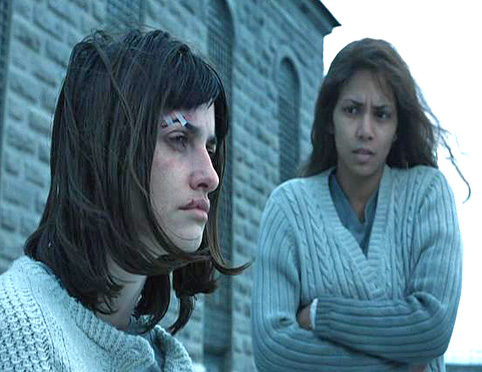(1999) Supernatural Horror (Warner Brothers) Geoffrey Rush, Famke Janssen, Taye Diggs, Peter Gallagher, Chris Kattan, Ali Larter, Bridgette Wilson, Max Perlich, Jeffrey Combes, Dick Beebe, Lisa Loeb, James Marsters, Peter Graves. Directed by William Malone
When done correctly, the haunted-house movie can be nearly ideal entertainment; claustrophobic, scary and sometimes spectacular, depending on the visual bent of the director.
Unfortunately, it’s very rarely done well, despite many attempts; my favorite remains The Legend of Hell House, which scores regular appearances on late-night television and is readily available on home video.. The House on Haunted Hill is a remake of a William Castle B-movie classic, updated for the ’90s with a stellar cast and crackerjack effects.
It begins at an insane asylum as the demented inmates riot against a sadistic staff, leading to a tragedy that kills all but five. Flash forward to the present, when theme park maven Stephen Price (Rush) – a sly tribute to the original movie’s star Vincent Price – has just finished debuting his newest roller coaster (actually the Incredible Hulk coaster at Orlando’s very own Islands of Adventure theme park, an experience I highly recommend if you haven’t already been) and is preparing to throw a birthday party for his less-than-loving wife (Janssen). He plans an unforgettable shindig.
However, the guest list is mysteriously altered, leaving only five complete strangers to try Price’s challenge; he’s put up a million dollars per guest (that’s five million dollars total) to be awarded to anyone who spends an entire night without leaving the notorious property known as the most haunted place in Los Angeles. This is, if you haven’t already guessed, the former asylum. Of course, you have to survive in order to collect. Who will it be – the mild mannered physician (Gallagher), the heroic leading man (Diggs), the plucky comic relief (Kattan) or the beautiful, sexy and intrepid woman (Larter)?
As is the case with many haunted house flicks, the house itself proves to have its own lethal intelligence. What was a mean-spirited prank turns into a fight for survival among stereotypes…err, I mean, characters. The writers throw in a misleading and totally unnecessary subplot involving Price’s marital woes and attempts by both parties to frame the other for murder, but it doesn’t wash for a moment.
The cast is led by Rush as Price, a showman along the lines of P.T. Barnum — or even, gulp, William Castle, the B-movie impresario who once wired theaters playing one of his movies to deliver mild electric shocks to patrons during key moments of the film. Rush is always outstanding and he manages to rise above the material here.
Taye Diggs makes for an excellent hero; he has a future as a widescreen leading man. Kattan provides comic relief as a caretaker who knows all too well what the house is capable of and proves to be one of the bright spots of the movie, something I never thought I’d say about the guy.
The effects are dazzling at times; the appearances of various ghosts and ghouls are genuinely creepy. The specter of Dr. Vannecutt (Jeffrey Combs) is particularly disturbing; it still weirds me out whenever I’m reminded of his appearance on a surveillance camera. The climactic portion of the movie revealing the monster at the heart of the haunting is a computer-generated Lovecraftian nightmare, but takes up far too much screen time; it would have made for better scares to show us less of the thing and more of the actors reactions to it.
In fact, as good as the effects are, they occasionally overpower what could have been a better movie if the filmmakers had focused more on genuine suspense and atmosphere instead of overpowering the senses. This got some notoriety as being the first film to be released from Dark Castle, the production company headed by Joel Silver, Robert Zemeckis, Gil Adler and Terry Castle, the daughter of the legendary producer. While they have since branched out from remakes of classic Castle films, they remain one of the finest regular producers of horror films in Hollywood.
“Less is More” is a truism that Hollywood moviemakers espouse onscreen but rarely follow behind the camera. House on Haunted Hill could have benefited from a budget slashed even more effectively than the designated female victim (see if you can guess who she’ll be at the beginning of the movie) who goes brainlessly and inevitably to her fate, wandering around in a dangerous house with a video camera – by herself. Kinda sums up the whole movie if you ask me.
WHY RENT THIS: Nice eye candy. Rush and Kattan give nice performances. Larter and Janssen are easy on the eyes.
WHY RENT SOMETHING ELSE: Overreliance on special effects. Would have done better creating more atmosphere and showing the monster less.
FAMILY MATTERS: Graphic horror violence, gore, some sexual images and lots of bad language; not for the squeamish.
TRIVIAL PURSUIT: The first person to get killed in the movie, a male nurse, is played by the writer of the screenplay Dick Beebe.
NOTABLE DVD FEATURES: There are trailers for both the 1999 and 1959 versions of the film, as well as a 20-minute feature comparing the two.
BOX OFFICE PERFORMANCE: $40.9M (North American box office figures only) on a $37M production budget; factor in worldwide box office and chances are this made money.
FINAL RATING: 5.5/10
NEXT: The Tempest


